#Behrman House
Photo

“161 Street Scene In Chinatown” c. 1885. Photograph by A.J. McDonald (from the Marilyn Blaisdell collection and the Oakland Museum of California).
Fatherly Images from Old Chinatown
Fatherhood is a timeless concept that transcends borders and cultures. Within the vibrant tapestry of San Francisco’s Chinatown during the pre-1906 era, the fathers of the community played a vital role in shaping the lives of their children and preserving the rich heritage of their ancestral homeland. Through their dedication, sacrifice, and unwavering commitment, these fathers navigated the often daunting challenges of a hostile, white supremacist polity while preserving their cultural traditions and nurturing a sense of identity within the first of what would be several new native-born generations produced by successive waves of the Chinese American diaspora.

“A Street Scene in Chinatown. San Francisco. Cal.” c. 1890. Stereograph by A.J. McDonald (from the collection of the OMCA).
Life in San Francisco Chinatown during the late 19th and early 20th centuries represented a complex tapestry of adversity and opportunity. The city’s first Chinese Americans faced discrimination, segregation, and the weight of economic privation. Yet, despite these obstacles, at least the photographic record presents the fathers of old Chinatown as beacons of strength and resilience for their families.
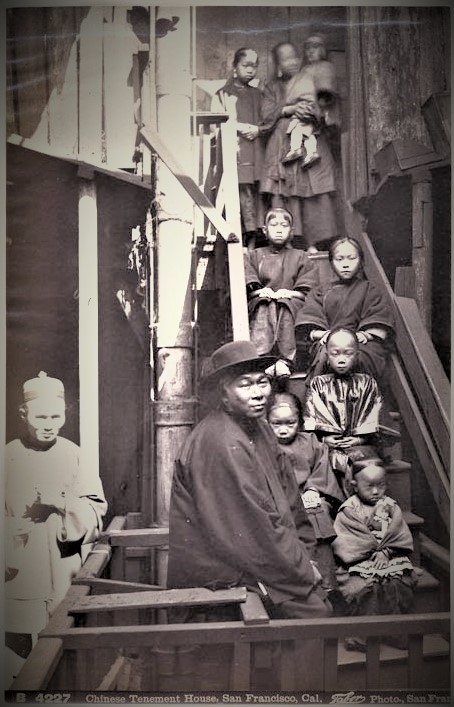
“B 4227 Chinese Tenement house, San Francisco, Cal.” c. 1884. Photograph by Isaiah West Taber (Martin Behrman Negative Collection / Courtesy of the Golden Gate NRA, Park Archives also from the California State Library). A Chinese father (or, as some viewers have more sinisterly implied, a “guardian”) for seven children and mother, posed on stairs leading to second floor entrance. A second man stands to left of the bottom of the stairs.

“B 5404 An Alley in Chinatown, San Francisco, Cal.” c. 1885. Photograph by Isaiah West Taber (from the Marilyn Blaisdell collection).
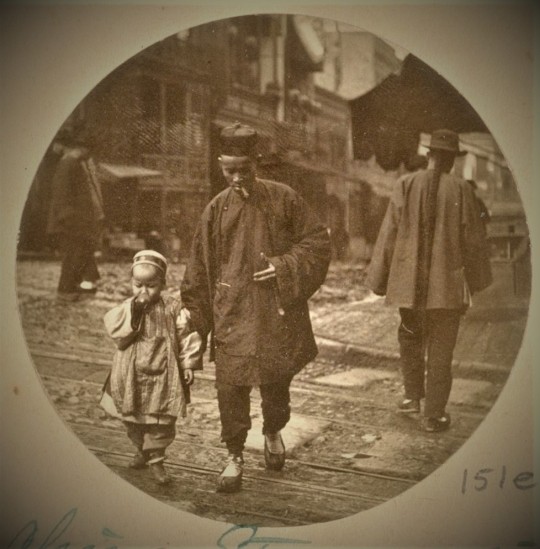
Cigar-smoking father and child crossing from what appears the northeast corner of Waverly Place and Clay Street, c. 1889. Photographer unknown (from the Jesse B. Cook collection at the Bancroft Library). In the background, the lanterns and façade of the Tin How temple appear on the west side of Waverly Place.
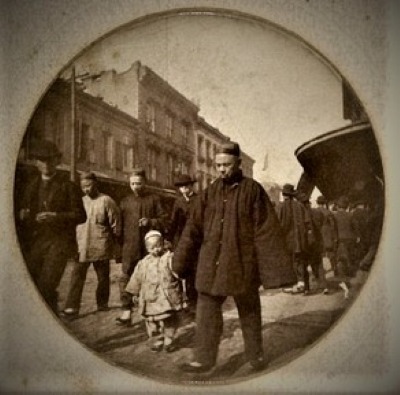
“Exterior View of Chinatown, San Francisco,” c. 1889. Father and child crossing a street. Photograph by Sam Cheney Partridge and printed by W.B. Tyler (from the collection of the Fine Arts Museums of San Francisco).

“Exterior View of Chinatown, San Francisco,” c. 1889. Father and child crossing a street, probably Dupont. Photograph by Sam Cheney Partridge and printed by W.B. Tyler (from the collection of the Fine Arts Museums of San Francisco).
Merchants in Chinatown carried the weight of responsibility on their shoulders. They built successful businesses, often establishing general stores, herb shops, or import-export enterprises. These fathers not only provided for their families' needs but also played a significant role in fostering economic stability within the community. They managed the intricate dynamics of trade, built networks, and navigated the challenges of language and cultural barriers. Through their entrepreneurial spirit, these fathers demonstrated perseverance, resourcefulness, and a commitment to creating a better future for their children.
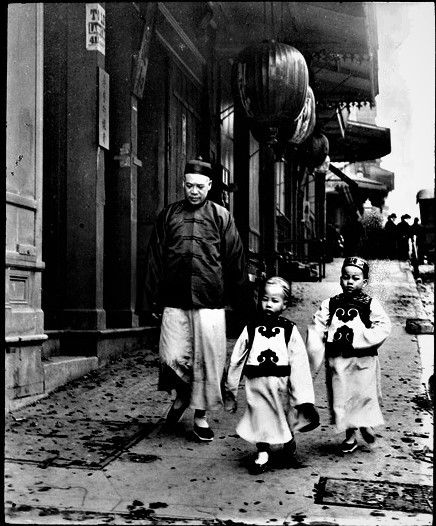
“Children of High Class” c. 1900. Photograph by Arnold Genthe (from the Genthe photograph collection, Library of Congress, Prints and Photographs Division). Merchant Lew Kan (a.k.a. Lee Kan) walking with his two sons, Lew Bing You (center) and Lew Bing Yuen (right). According to historian Jack Tchen, “Lew Kan was a labor manager of Chinese working in the Alaskan canneries. He also operated a store called Fook On Lung at 714 Sacramento Street between Kearney [sic] and Dupont. Mr. Lew was known for his great height, being over six feet tall, and his great wealth. The boys are wearing very formal clothing made of satin with a black velvet overlay. The double mushroom designs on the boys’ tunics are symbolic of the scepter of Buddha and long life.”

Father and child c. 1889. Photographer unknown (from the Jesse B. Cook collection at the Bancroft Library).
On the other hand, fathers working as laborers in Chinatown faced arduous working conditions and limited job opportunities. Many found employment in industries such as laundries, restaurants, or as laborers on the Central Pacific Railroad. These fathers toiled tirelessly to ensure their children had a better life than their own, often enduring long hours and physically demanding work. They displayed immense determination, resilience, and selflessness as they braved harsh conditions and discriminatory practices.

Young girls crossing the cable car tracks on Clay Street at the northeast corner of its intersection with Dupont under the watchful eye of their father, c. 1890. Photographer unknown (from the Marilyn Blaisdell collection).
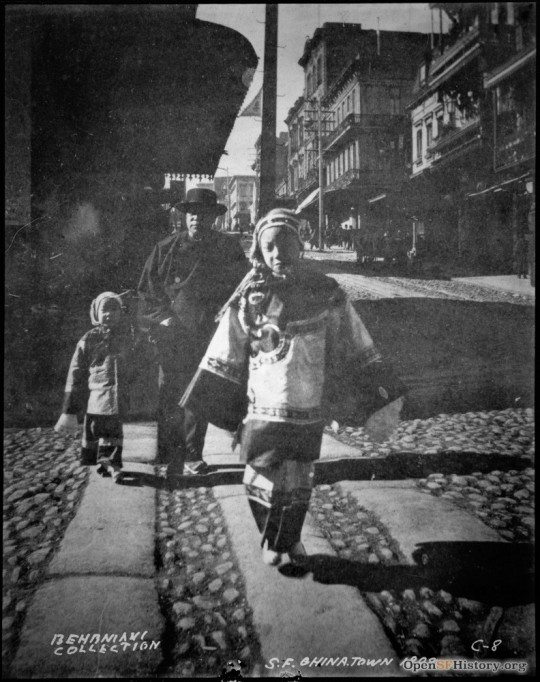
“S.F. Chinatown 1898.” Photographer unknown (from the Martin Behrmann Collection of the GGNRA). The daughters’ festive attire suggests that this image was taken during the Chinese New Year holidays. The incline of the hill, the appearance of the lanterns hanging from the double-balcony façade of the Yoot Hong Low restaurant at the right of the photo, and the cable car tracks in the background indicate that the trio were walking east on Clay Street and crossing Dupont Street from the southwestern to the southeastern corner of the intersection.
Regardless of their occupation, fathers in Chinatown shared a common goal: providing for their families and instilling values in their children. They recognized that education was the key to unlocking doors of opportunity and breaking free from the confines of poverty, if not segregation. Despite facing language barriers and limited resources, these fathers encouraged their children to pursue knowledge and acquire skills that would help them succeed in the ever-changing landscape of America.

Chinese American men and child in front of building with hanging lanterns, Chinatown, San Francisco, c. 1896 - 1906. Father and infant conferring with a smoking man on the sidewalk in front of a store. Photo by Arnold Genthe (from the Genthe photograph collection, Library of Congress, Prints and Photographs Division).
Fatherhood in old Chinatown was also a testament to the unwavering support and sacrifice made for the well-being of the family. Many fathers left their homes and families behind in China, enduring years of separation to seek better opportunities in the United States. Their commitment to their families was demonstrated through their remittances, which provided financial stability and, for a lucky few during the Exclusion era, allowed their loved ones to join them in the new world.

“A Holiday Visit” c. 1897. Photo by Arnold Genthe (from the Genthe photograph collection, Library of Congress, Prints and Photographs Division). According to historian Jack Tchen: “The baby is wearing Western shoes. The girl with the balloon is a member of the SooHoo family. She was one of three sisters and four brothers. She later married a Jung and had eight children. After the earthquake, her father was a carpenter for white families who needed skilled craftsmen to restore their houses.”

Father follows two children with another father and infant seen on the corner in the background, c. 1900. Photographer unknown (from a private collection). This image has been corrected from the opensfhistory.org website.

Father and child walking north on Dupont Street, c. 1900. Photographer unknown (from a private collection). The darker signage in the upper right reads: 仁安堂衛生鋈酒 (canto: “Yan On Tong wai saang yook jau”; lit. “Benevolent Peace hall hygienic liquor”).
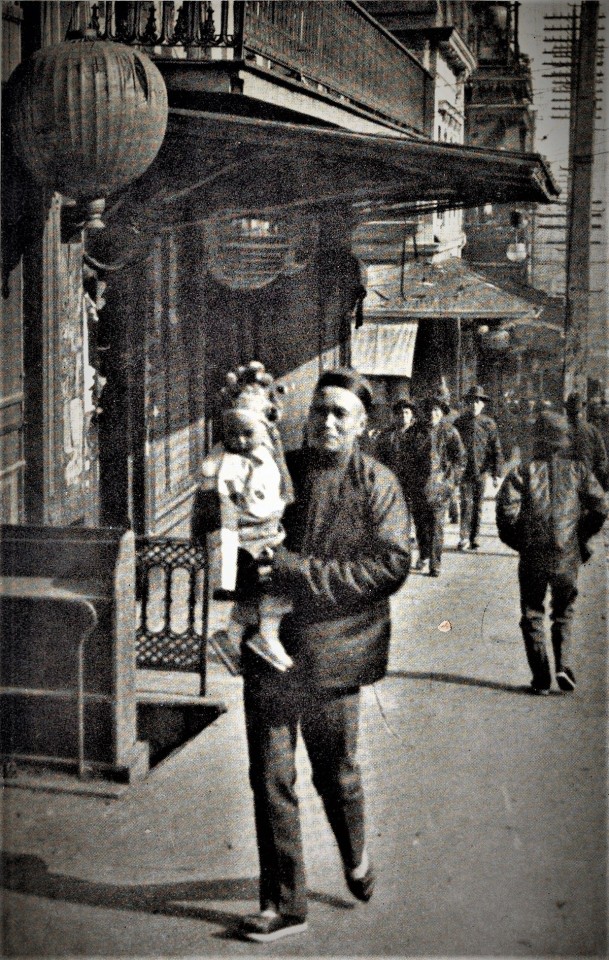
“New Year’s Day in Chinatown” c. 1900. Photograph by Arnold Genthe (from the Genthe photograph collection, Library of Congress, Prints and Photographs Division). “Nearly half of Genthe’s Chinatown photographs were taken during some community holiday,” historian Jack Tchen has written. “The merchant and child are walking westward up Clay Street just above Waverly Place. The lantern directly in line with the boy’s head is a sign for the Siyi [四邑; canto: “sei yap”], or Four Districts, Association located at 820 Clay Street.”

A father holds his child as he converses with two men whose faces are shadowed in front of a sidewalk stall. No date, photographer unknown (from a private collection).

“Paying New Year’s Calls” c. 1900. Photograph by Arnold Genthe (from the Genthe photograph collection, Library of Congress, Prints and Photographs Division). The two men and children appear to be walking south on Dupont Street and crossing to the southeastern corner of its intersection with Clay Street.
One can infer from the many photos that Arnold Genthe and other photographers took of fathers and holiday-garbed children that the photographers captured activities around the second day or “beginning” of Chinese New Year (開年; canto: “hoi nien”; pinyin: “kāinián”), including paying visits (or 拜年; canto: “bye nien”) to relatives for the renewal of family ties and to close friends for relationship-building.

“Scene in Chinatown San Francisco” c. 1900. Photographer unknown (from a private collection).

Photograph by Arnold Genthe (from the Genthe photograph collection, Library of Congress, Prints and Photographs Division). Historian Jack Tchen wrote about this image as follows: “. . . In [Genthe’s book] Old Chinatown this photo was entitled ‘He Belong Me.’ The bull’s-eye sign further down Washington Street indicates a shooting gallery. This block was only half Chinese.” The window signage seen in the immediate background shows W.D. Hobro, “Gas & Steam Fitting,” at 728 Washington Street, across from Portsmouth Square, ca. 1897. “Hobro ran a lucrative plumbing business serving the Chinatown area,” Tchen has written. “Chinese were not allowed into the plumbers’ union until the late 1950s.”
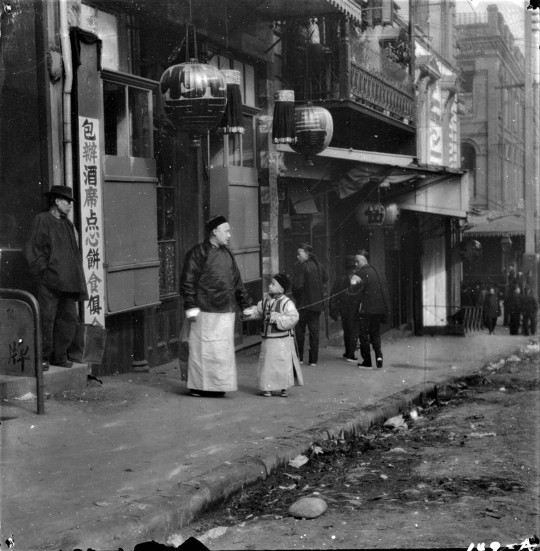
“A Family from the Consulate, Chinatown, San Francisco,” c. 1900-1906. Photograph by Arnold Genthe from the Genthe photograph collection, Library of Congress, Prints and Photographs Division. A father and son (with a balloon), attired as befitted a merchant family, walking west on the north side of Clay above Dupont Street. More modestly-dressed passersby stare at the pair, perhaps in recognition of the man’s status as a consular official. The long vertical signage parallel to the drainpipe in the left-hand part of the image has been damaged. Other photos from this period show the complete sign as 包辩酒席占点心餅食俱全 (canto: “bow bin jau jik tin dim sum behng sihk geuih chuen”) or 包辦酒席 “= can host banquet;” 點心餅食 “= dim sum bakery;” 俱全 “ = both or complete.” The writing on the lanterns at the ground floor identifies a restaurant as 悦香酒樓 (canto: “Yuet Heung Low”). The shuttered storefront of the Yoot Hong Low restaurant’s premises at 810 Clay Street indicates that the building was closed for the New Year holiday.

A father walks with his family north on Ross Alley, no date. Photographer unknown (from a private collection).
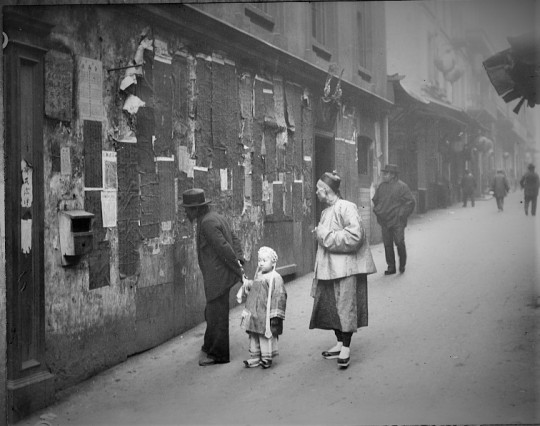
Ross Alley from Jackson Street, c. 1898. Photo by Arnold Genthe (from the Genthe photograph collection, Library of Congress, Prints and Photographs Division). Historian Jack Tchen: “The wooden box affixed to the wall on the left was for disposing of paper scraps. Genthe inaccurately entitled this photograph ‘Reading the Tong Proclamation.’ According to many guide pamphlets and books written during this time, these notices proclaimed who would be the next victim of tong ‘hatchet men.’ In actuality, they reported a variety of community news.”
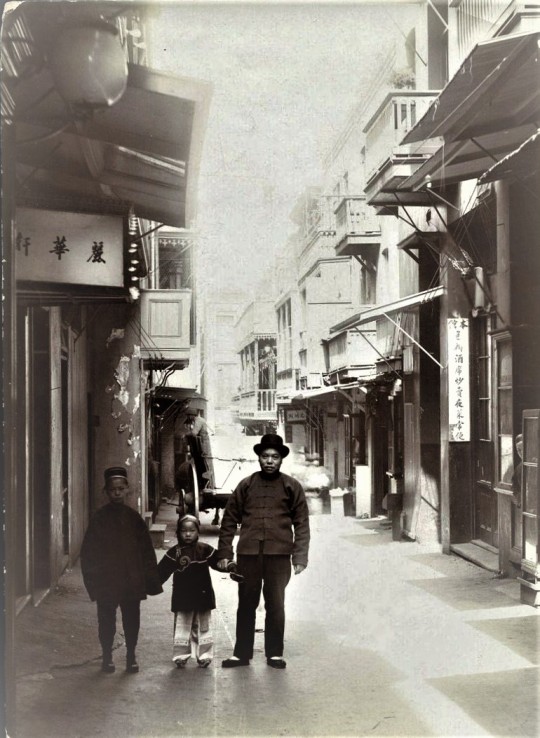
A Chinese merchant with his two children in Ross Alley of pre-1906 San Francisco Chinatown, c. 1902. Photograph attributed to Charles Weidner (from a private collection).

Chinese merchant and his children. Photographer possibly by Charles Weidner (from the Cooper Chow collection at the Chinese Historical Society of America). This image appears to be a continuation shot of the same trio of father, daughter and son Weidner took in Ross Alley. All three are wearing the same clothes and posing in front of what is probably the father’s business premises. Outside of his store, the merchant shows more of a smile as he looks directly at the camera lens, perhaps more familiar with the photographer. Even his son has started to show the beginning traces of a smile. This implies that the photographer either followed the trio from Ross Alley to the father’s place of business or encountered the merchant and his offspring for another photo. Prominent advertising signage appears above the doorway to the business which reads from right to left as follows: 廣珍號珍珠玉器金銀首飾男女新衣蘇杭發客 or roughly “Guangzhen Pearl Jade Gold and Silver Jewelry Men’s and Women’s New Clothes Suzhou and Hangzhou” (pinyin: “Guǎng zhēn hào zhēnzhū yùqì jīnyín shǒushì nánnǚ xīn yī sūhángfā kè “; canto: “Gwong Zun ho sunjiu yok hay gam ngan sau sik nam neuih sun yee so hong faat haak”). The barely discernible calligraphy on the upper-right pane of the store window frame bears the probable business name, 廣珍 (“Gwong Zun”). Magnification of the window reveals at several photographs that can be seen through the window. At least four framed photos are visible on a wall behind a desk. On the most discernible of the photos, a figure appears to be seated and holding a fan – a pose commonly used by Chinese subjects in the studio portraiture of the late 19th century. The figure could be an ancestor or even the merchant’s wife, as photos became essential evidence to overcome the hurdles to the effective denial of entry to the US by Chinese females after the enactment of the Page Act of 1875 which purported to bar the immigration of prostitutes. A couple of wooden shutters appear behind the merchant and his son. The panels would have been used to cover the window as a security measure. A similar set of shutters also appear at the far right of the photo frame, indicating the merchant shared this alleyway or street with other businesses. Unfortunately, the signage (appearing in the upper right-hand corner of the frame), for what appears to be a street number or street name is illegible.
The fathers of old San Francisco Chinatown were unsung heroes who forged a path for future generations. Whether as successful merchants or hardworking laborers, their contributions to their families and community were immeasurable. Their legacy is deeply ingrained in the history and fabric of modern-day Chinatown and the mythology of Chinese America itself, where their sacrifices and contributions are remembered and celebrated.
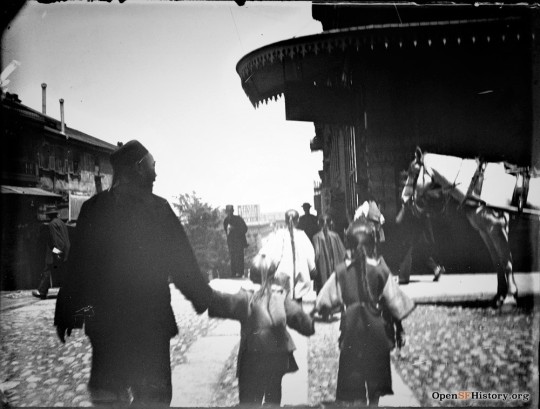
A father escorts his two children across Dupont Street, heading west down the hill on the south side of Clay Street, c. 1886. Photographer unknown (from a private collection). The trees of Portsmouth Square park can be seen in the distance.
Today, the descendants of these fathers continue to honor their heritage, proudly embracing their Chinese American identity while embodying the resilience and determination that their fathers instilled in them.
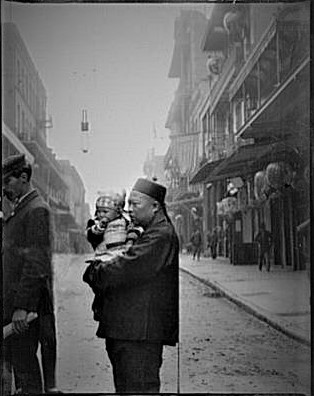
“A Proud Father” c. 1900-1905. Photo by Arnold Genthe (from the Genthe photograph collection, Library of Congress, Prints and Photographs Division). A father and child are seen crossing Dupont Street at its intersection with Clay Street from the northeastern to northwestern corner. The lanterns and balconies of the Wauy Sin Low restaurant at 808 Dupont can be seen in the background at right. According to historian Jack Tchen, “[a] man’s elbow has been etched out of the photograph. The object hanging above the street is an electric street light attached to a pulley. When the bulb burned out, the light would be pulled over to the side of the street and changed.”

“Man and boy walking on street” c. 1900-1905. Photo by Arnold Genthe (from the Genthe photograph collection, Library of Congress, Prints and Photographs Division). Based on his dress, the man appears to be a merchant. The boy’s festive dress indicates that the photo was taken during a holiday.

“Man and children walking down a street,” c. 1900-1905. Photo by Arnold Genthe (from the Genthe photograph collection, Library of Congress, Prints and Photographs Division).
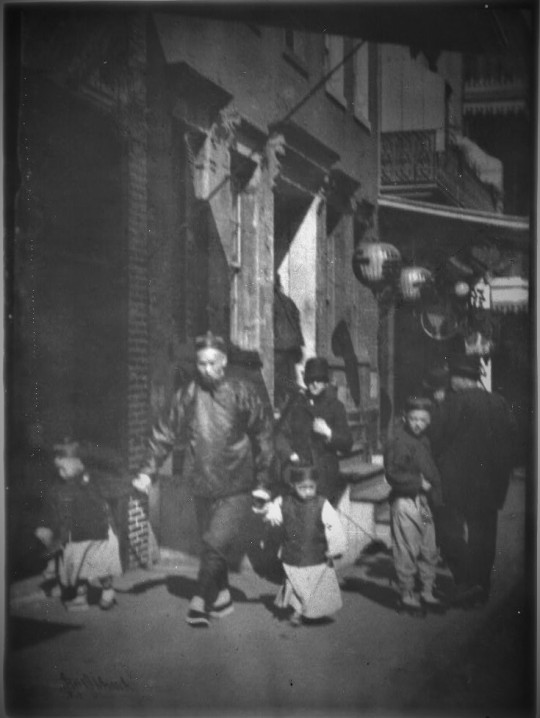
“Man and two boys walking along a street,” c. 1900-1905. Photo by Arnold Genthe (from the Genthe photograph collection, Library of Congress, Prints and Photographs Division). Based on his dress, the man appears to be a merchant. The boy’s festive dress indicates that the photo was taken during a holiday.

“Man and two children crossing a street,” c. 1900-1905. Photo by Arnold Genthe (from the Genthe photograph collection, Library of Congress, Prints and Photographs Division).

“Man and a young child walking,” c. 1900-1905. Photo by Arnold Genthe (from the Genthe photograph collection, Library of Congress, Prints and Photographs Division).

“Man carrying a child accompanied by another child,” “Man and two children crossing a street,” c. 1900-1905. Photo by Arnold Genthe (from the Genthe photograph collection, Library of Congress, Prints and Photographs Division).
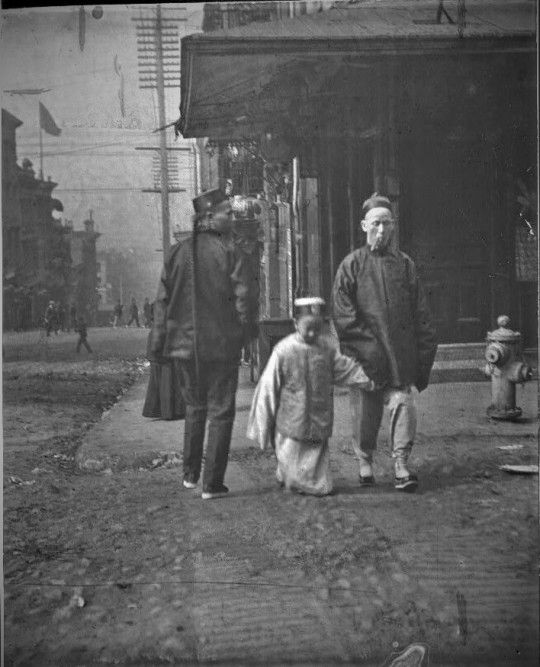
“Boy and a man smoking a cigar crossing a street,” “Man and two children crossing a street,” c. 1900-1905. Photo by Arnold Genthe (from the Genthe photograph collection, Library of Congress, Prints and Photographs Division).

“Waiting for the Car” c. 1904. Photo by Arnold Genthe (from the Genthe photograph collection, Library of Congress, Prints and Photographs Division). Historian Jack Tchen writes about this photo as follows: “The Sue family at a Dupont Street corner. Mrs. Sue is shown with her eldest daughter, Alice, with Elsie sandwiched between them. Her brother-in-law is holding Harris. Alice is wearing strings of pearls and semiprecious stones on her head dress. Mrs. Sue is wearing a black silk-on-silk embroidered outfit. Married women generally wore dark, subdued clothing that distinguished them from prostitutes. Elsie and Harris are wearing leather shoes; however, Alice and her mother wear Chinese-style footwear. Mr. Sue, who died after the 1906 earthquake, ran a doc sic guun, or “boarding house,” which fed male workers at nine in the morning and four in the afternoon, while Mrs. Sue took in sewing. (Information provided by Alice Sue Fun.)”
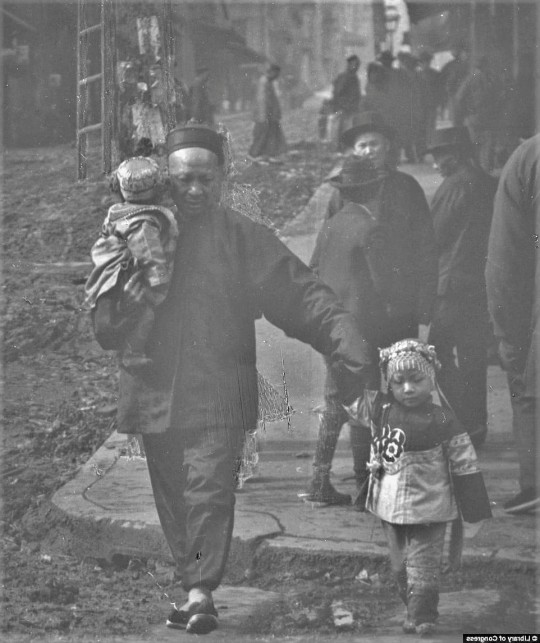
Father and two children walking downhill (probably Sacramento Street), c. 1904. Photo by Arnold Genthe (from the Genthe photograph collection, Library of Congress, Prints and Photographs Division). The girl’s festive dress indicates that the photograph was taken during the New Year holidays.

A sidewalk store proprietor/operator with his children, c. pre-1906. Postcard variant of a lithograph (from the collection of the Society of California Pioneers). Other card variants bear the caption “Chin Kee and family, Chinese Street Merchant, Dupont and Washington Sts. Chinatown, San Francisco” such as the card by Britton & Rey, Lithographers, San Francisco 515 (from the private collection of Wong Yuen-ming). To read more about the sidewalk stalls of old San Francisco Chinatown, go here.

“Dressed for a Visit” c. 1896 - 1906. Photograph by Arnold Genthe (from the Genthe photograph collection, Library of Congress, Prints and Photographs Division). Historian Jack Tchen: “This photograph happens to capture the sign for the ‘Chinese Newspaper/War Kee’ at 803 Washington Street, just west of Dupont Street. The War Kee was founded in 1875. Although the names J. Hoffman and Chock Wong appear as the publishers of the first issue, a Yee Jenn has been cited as the founder. The War Kee, which was the first successful Chinese weekly published in Tangrenbu, folded in 1903. [Note: The Langley directory for 1876 contains a listing in its newspapers section for "Oriental (Chinese) Chock Wong & J. Hoffmann, 817 Washington." This address would have placed its first offices on the south side of Washington Street across from the southern entrance to Ross Alley.]
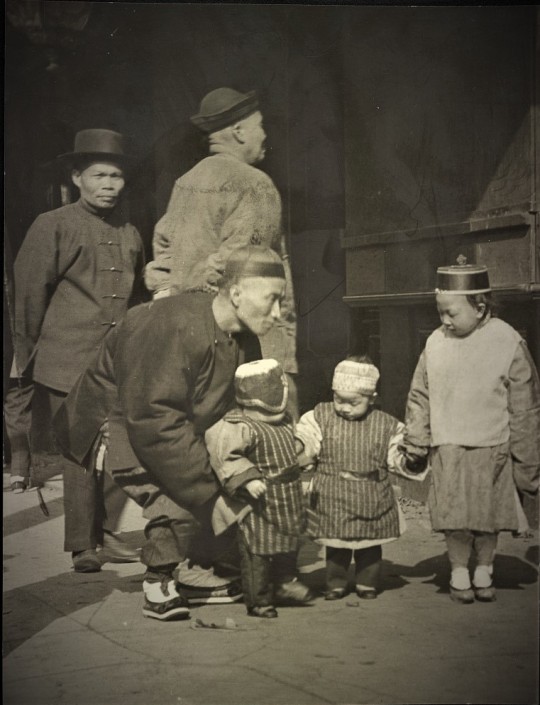
Chinese American men and three children in traditional dress standing on a street in Chinatown, San Francisco, c. 1896 - 1906. Photograph by Arnold Genthe (from the Genthe photograph collection, Library of Congress, Prints and Photographs Division).

“The Proud Father” c. 1905. Photo by Mervyn D. Silberstein (from a private collection). Silberstein specialized in photography of San Francisco Chinatown residents and producing hand-colored reproductions in “actual Chinese color combinations.” Silberstein’s own ads for his “Chinee-Graphs” promoted “[m]ost of these pictures were taken during the Chinese New Year festivities many years ago when the ancient customs were adhered to.”
[updated 2023-6-30]
#Chinese fathers of old San Francisco Chinatown#Lew Kan#Ross Alley#Dupont Street#Arnold Genthe#Sam Cheney Partridge#Chin Kee and family#Jack Tchen#Wauy Sin Low restaurant#A.J. McDonald#Charles Weidner
3 notes
·
View notes
Link
Check out this listing I just added to my Poshmark closet: Esther Didn't Dream of Being Queen by Allison Ofanansky (2021, Hardcover).
0 notes
Text
The Ledge #604: Odds & Ends Again
The "odds and ends" series is an opportunity for me to mix all kinds of material. This week's version mixes a bunch of new releases with a ton of material I've been playing around the house in recent weeks. There's also a tribute to Mary Weiss, the leader of The Shangri-Las who passed away a few days ago. Otherwise, there's classics by The Clash, X, The Birthday Party, and The Long Ryders, along with a new discovery of The Deviants, a great old band that for whatever reason I had never checked out.
CLICK HERE TO DOWNLOAD THE SHOW!
1. The Replacements - Alex Chilton (Rough Mix)
2. The Shangri-Las - Give Him a Great Big Kiss
3. Mary Weiss with the Reigning Sound - Nobody Knows (But I Do)
4. X - I Must Not Think Bad Thoughts
5. The Clash - All the Young Punks (New Boots and Contracts)
6. Lorne Behrman - The Blue Goes On Forever
7. The Jack Rubies - Hark
8. The Trouble Seekers - Not like U
9. Ty Segall - My Best Friend
10. The Deviants - I'm Coming Home
11. 13th Floor Elevators - Reverberation (Doubt)
12. The Leaves - Tobacco Road
13. Thee Headcoats - Troubled Times
14. Night Beats - Cinderella
15. Robbie Quine - Let's Spend the Night Together
16. Roxanne Fontana - The Singer Not The Song
17. The Weeklings - Mr. Soul Satisfaction
18. The Speakeasy - Johnny B. Goode
19. Soul Asylum - Attacking The Beat
20. Tommy Keene - Back to Zero Now
21. The Beat Farmers - Gun Sale at the Church
22. The Long Ryders - Run Dusty Run
23. Suburbs - Baby Heartbeat
24. The Boatsmen - Why Wait
25. Jonesy - (If It's Not Rock 'N Roll) Go To Hell
26. Oblivians - I'll Be Gone
27. Cheap Trick - Clock Strikes Ten
28. The Birthday Party - Nick the Stripper
29. Sonic Youth - Death Valley '69
30. Spacemen 3 - Things'll Never Be The Same (demo version)
31. The Chills - Look for the Good in Others and They'll See the Good in You
32. Nancy Sinatra - Got It Together
0 notes
Text
Exploring Collectibility and Selling Vintage Treasures.

Introduction:
Madame Alexander dolls hold a special place in the hearts of collectors and enthusiasts worldwide. Crafted with meticulous detail and imbued with a timeless charm, these dolls have become cherished treasures, evoking nostalgia and capturing the imagination of generations. In this article, we delve into the enchanting world of Madame Alexander dolls, exploring their allure, vintage appeal, and the considerations when selling these valuable collectibles.
The Legacy of Madame Alexander Dolls:
Founded by Beatrice Alexander Behrman in the 1920s, the Madame Alexander Doll Company quickly gained acclaim for its exquisite craftsmanship and attention to detail. Each doll was meticulously designed, reflecting the fashion trends, historical periods, and cultural influences of its time. From iconic characters to intricate ballerinas and storybook figures, Madame Alexander dolls encapsulated a world of imagination within their delicate forms.
The Vintage Allure:
Madame Alexander dolls from bygone eras possess a vintage charm that continues to captivate collectors. Dolls crafted in the mid-20th century, especially those from the 1930s to the 1960s, often hold significant appeal due to their historical relevance, craftsmanship, and limited production runs. These vintage dolls, with their fine materials, hand-painted faces, and intricate costumes, represent a golden age of doll-making, making them highly sought after by collectors.
Understanding Madame Alexander Doll Values:
The value of Madame Alexander dolls can vary widely based on several factors. Condition plays a pivotal role; dolls in pristine condition, complete with original accessories and packaging, tend to command higher prices. Rarity is another significant factor influencing value. Limited editions, discontinued lines, and dolls with unique features or outfits often fetch premium prices in the collector's market.
Moreover, the popularity of specific doll series or themes can impact their value. Dolls modeled after famous characters, royalty, or cultural icons, as well as those representing significant historical periods or events, tend to attract greater interest and higher values among collectors.
Selling Madame Alexander Dolls:
For individuals looking to sell Madame Alexander dolls from their collection, several avenues exist to ensure a successful and rewarding transaction. Online marketplaces dedicated to collectibles and antique dolls serve as convenient platforms to reach a broad audience of potential buyers.
Prior to selling, conducting thorough research to assess the current market trends and values of specific dolls is crucial. Factors such as rarity, condition, provenance, and completeness of the doll and its accessories should be accurately evaluated to determine a fair asking price.
Additionally, engaging with specialized auction houses or attending doll shows and conventions can be beneficial. These events attract passionate collectors and experts who appreciate the value of Madame Alexander dolls, providing opportunities to connect with potential buyers willing to pay a premium for coveted pieces.
Preserving the Legacy:
Preserving the legacy of Madame Alexander dolls involves more than just their monetary value. These dolls represent a cultural heritage and a significant part of the history of toy-making. Proper care and preservation of these treasures ensure that future generations can appreciate and enjoy their beauty and craftsmanship.
Tips for Sellers:
Research and Appraisal: Conduct thorough research on your dolls, considering their age, condition, and historical significance. Seeking professional appraisals or consulting with experts can provide insights into their value.
Presentation and Documentation: Present dolls accurately with detailed descriptions and high-quality images. Maintain any original certificates, boxes, or accessories, as they add authenticity and value.
Choosing the Right Platform: Select reputable online platforms, auction houses, or specialty doll markets known for catering to collectors of Madame Alexander dolls.
Networking and Engagement: Engage with collector communities, forums, or social media groups dedicated to doll enthusiasts. Networking can lead to potential buyers interested in specific dolls or series.
Conclusion:
Madame Alexander dolls continue to enchant collectors with their beauty, craftsmanship, and historical significance. Their enduring appeal as collectibles lies in their meticulous details, nostalgic charm, and the stories they evoke. For those considering selling these cherished treasures, understanding their value, finding the right market, and preserving their legacy are essential steps in ensuring a rewarding and meaningful transaction that honors the legacy of these beloved dolls.
0 notes
Text
22/17b
#23GloPoWriMo
Prompt Dated : 2023 April 17
Response No : 1
Poem No: 22
%^%^%^%^%^%^%^%^%^%^%^%^%^%^%^
Prompt :
Today’s challenge asks you to write a poem that contains the name of a specific variety of edible plant – preferably one that grows in your area.
In the poem, try to make a specific comparison between some aspect of the plant’s lifespan and your own – or the life of someone close to you. Also, include at least one repeating phrase.
%^%^%^%^%^%^%^%^%^%^%^%^%^%^%^
Poem Title :
The Milky Dudhiya Digha Maldah Mango
%^%^%^%^%^%^%^%^%^%^%^%^%^%^%^
Only about a hundred years
Is the life- span of the Dudhiya Maldah
The voluptuously fragrantly gorgeous Milky Mango
A cultivar of the magnificent Mangifera Indica
Grown only in the few square miles embraced
By the Ganga and the Sone in their eponymous confluence
In Digha, a name both generic for riverine confluences
And specific to the area of Patna where I live.
Digha, in Patna, is the name given
To a post office, a railway station, a boat harbour,
A cremation ghat, a police station, a community development block
A river bridge,a geographical location , and
To the most delicious Mango in the world
The Dudhiya Digha Maldah, in whose praise,
I am given to writing odes, Horation,
( after Andrew Marvell ), and paeans, pugnacious,
For I cannot possibly allow anyone anywhere
To contest the absolute supremacy
Of the Emperor among the Kings of Fruit, Mangoes,
In looks, in taste, in flavour, in fragrance,
In sweetness, in tartness, in juiciness,
In pulpiness, in satisfying scrumptiousness -
My pen and my life are ever at its command !
A Nawab of Awadh visiting Lahore in 1930
Picked up some saplings of a mango he liked
And brought them to his mother’s home in Patna
Planted them there and asked for surplus milk
From the royal dairy to be poured into the roots
Of these young saplings, not knowing their fruit
Forever would get sweetened by this care,
It’s very DNA would change and thus create
The Milky Digha Maldah Mango, much sought after
By kings and princes , premiers and presidents,
To this day, when kingdoms have vanished
And builders rule the roost, who have destroyed
It’s very habitat, rendering my pen,
And those of others here in this harsh world
It’s sole defence against the power of lucre.
2023, the Dudhiya Digha Maldah is dying ,
The Sacred Ganga helpless at Man’s greed
No water meadows lush with Ganga waters
No fat and happy cows fed on that grass
No milk to spare for watering Mango Trees
No land spared by the new-carved colonies
Markets and malls and big housing estates
Flyovers over black macadam roads
Concrete killing this precious habitat.
Only about a hundred years, then, has been
The life-span of this most wonderful of Mangoes
Created by Man working in harmony
With Mother Nature.
The Dudhiya Digha Maldah is dying
And helpless though fighting in its defence
So am I.
We cannot go out, you and I,
And reverse urbanisation and the end
Of pastoral life under ruthless neo- liberalism
We cannot fight the new Dragon, Development,
We will not hear the mermaids singing each to each.
One of these days
DDM and I
will quietly die.
It’s a bit like the Last Leaf
Only there’s no Behrman.
%^%^%^%^%^%^%^%^%^%^%^%^%^%^%^
Poet : Amita Sarjit Ahluwalia
Poem 22 / 17 th Day
%^%^%^%^%^%^%^%^%^%^%^%^%^%^%^
0 notes
Text
Awakenings by Rabbi Joshua Stanton, Rabbi Benjamin Spratt
Awakenings by Rabbi Joshua Stanton, Rabbi Benjamin Spratt
American Jewish Transformations in Identity, Leadership, and Belonging
Foreword: Rev Kaji DousaAfterword: Dr. Eboo Patel
Why are religious organizations on the decline? What changes have caused many of them to lose touch with modern spiritual needs? What does it take to remain relevant in today’s world? Rabbis Joshua Stanton and Benjamin Spratt take on these and other critical questions facing…

View On WordPress
0 notes
Text
Not for Everyone: A grand list of 143 weird books
This is my meticulously curated list of 143 of the weirdest books I’ve ever read. Weird here can mean subject matter, the way it was written, or just that it’s off the beaten path. It certainly does not include every weird book out there. But it is a start if you are interested in reading weird lit yet have no idea where to begin. I encourage you to dig in... if you dare.
1. Dirty Secret: A Daughter Comes Clean About Her Mother's Compulsive Hoarding by Jessie Sholl, (2010)
2. Ghost Story by Peter Straub, (1989)
3. My Life Among the Serial Killers: Inside the Minds of the World's Most Notorious Murderers by Helen Morrison and Harold Goldberg, (2004)
4. The Amityville Horror by Jay Anson, (1977)
5. Sophie Crumb: Evolution of a Crazy Artist by Sophie Crumb, (2010)
6. The Farm: Life Inside a Women's Prison by Andi Rierden, (1997)
7. On the Bus: The Complete Guide to the Legendary Trip of Ken Kesey and the Merry Pranksters and the Birth of Counterculture by Paul Perry, (1997)
8. The Haunting of Hill House by Shirley Jackson, (1959)
9. Nightwork: Sexuality, Pleasure, and Corporate Masculinity in a Tokyo Hostess Club by Anne Allison, (1994)
10. The A-Z Encyclopedia of Serial Killers by Harold Schechter, (1996)
11. Not Without my Daughter by Betty Mahmoody, (1987)
12. Herland by Charlotte Perkins Gilman, (1915)
13. Sybil: The Classic True Story of a Woman Possessed by Sixteen Personalities by Flora Rheta Schreiber, (1973)
14. Electroboy: A Memoir of Mania by Andy Behrman, (2002)
15. You Better Not Cry: Stories for Christmas by Augusten Burroughs, (2009)
16. Snuff by Chuck Palahniuk, (2008)
17. Pimp: The Story of my Life by Iceberg Slim, (1967)
18. Black Hole by Charles Burns, (2005)
19. My Lobotomy by Howard Dully and Charles Fleming, (2007)
20. Fun Home: A Family Tragicomic by Alison Bechdel, (2006)
21. Hell’s Angels: A Strange and Terrible Saga by Hunter S. Thompson, (1966)
22. The Electric Kool-aid Acid Test by Tom Wolfe, (1968)
23. Hardcore Mother by Maxon Crumb, (2001)
24. In the Heart of the Sea: The Tragedy of the Whaleship Essex by Nathaniel Philbrick, (2000)
25. House of Leaves and The Whalestoe Letters by Mark Z. Danielewski, (2000)
26. Tweak: Growing up on Methamphetamines by Nic Sheff, (2008)
27. Fear and Loathing in Las Vegas: A Savage Journey to the Heart of the American Dream by Hunter S. Thompson, (1971)
28. I Like You: Hospitality under the Influence by Amy Sedaris, (2006)
29. Stranger than Fiction by Chuck Palahniuk, (2004)
30. SantaLand Diaries by David Sedaris, (1998)
31. Trout Fishing in America/ The Pill vs. The Springhill Mine Disaster/ In Watermelon Sugar by Richard Brautigan, (1989)
32. The Long, Hard Road out of Hell by Marilyn Manson, (1998)
33. Naked Lunch by William S. Burroughs, (1959)
34. She’s Come Undone by Wally Lamb, (1992)
35. Simple Times: Crafts for Poor People by Amy Sedaris, (2010)
36. Voluntary Madness: My Year Lost and Found in the Loony Bin by Norah Vincent, (2008)
37. The Cannibals of Candyland by Carlton Mellick III, (2009)
38. The Sallie House Haunting by Debra Lyn Pickman, (2010)
39. The Demonologist by Gerard Brittle, (1980)
40. Off Season (Dead River #1) by Jack Ketchum, (1980)
41. Room by Emma Donoghue, (2010)
42. The Girl Next Door by Jack Ketchum, (1989)
43. The Lottery and Other Stories by Shirley Jackson, (1949)
44. When Rabbit Howls by Truddi Chase, (1987)
45. Red Dragon by Thomas Harris, (1981)
46. Dark Places by Gillian Flynn, (2009)
47. The Hot House: Life Inside Leavenworth Prison by Pete Earley, (1992)
48. Ted Bundy: Conversations with a Killer by Stephen Michaud and Hugh Aynesworth, (1989)
49. Devil’s Knot: The True Story of the West Memphis Three by Mara Leveritt, (2002)
50. The Ice Man: Confessions of a Mafia Contract Killer by Philip Carlo, (2006)
51. The Complete Grimm’s Fairytales by Jacob and Wilhelm Grimm, (1812)
52. Lost at Sea: The Jon Ronson Mysteries by Jon Ronson, (2012)
53. Them: Adventures with Extremists by Jon Ronson, (2001)
54. The Psychopath Test: A Journey through the Madness Industry by Jon Ronson, (2011)
55. Life After Death by Damien Echols, (2012)
56. The Nasty Bits: Collected Varietal Cuts, Usable Trim, Scraps, and Bones by Anthony Bourdain, (2005)
57. Damned by Chuck Palahniuk, (2011)
58. Party Monster: A Fabulous but True Tale of Murder in Clubland by James St. James, (1999)
59. What Cops Know by Connie Fletcher, (1990)
60. Mommie Dearest by Christina Crawford, (1978)
61. I’m Down Mishna Wolf, (2009)
62. Jesus Land: A Memoir by Julia Scheeres, (2005)
63. Free For All: Oddballs, Geeks, and Gangstas in the Public Library by Don Borchert, (2007)
64. Sickened: The Memoir of a Munchausen by Proxy Childhood by Julie Gregory, (2003)
65. Newjack: Guarding Sing Sing by Ted Conover, (1999)
66. Word Freak: Heartbreak, Triumph, Genius, and Obsession in the World of Competitive Scrabble Players by Stefan Fatsis, (2001)
67. Napalm & Silly Putty by George Carlin, (2001)
68. Crimson Stain by Jim Fisher, (2000)
69. Are you my Mother? A Comic Drama by Alison Bechdel, (2012)
70. The Complete Persepolis by Satrapi Marjane, (2003)
71. Something Wicked This Way Comes by Ray Bradbury, (1962)
72. Hunger Makes Me A Modern Girl by Carrie Brownstein, (2015)
73. Drinking at the Movies by Julia Wertz, (2010)
74. Calling Dr. Laura by Nicole J. Georges, (2013)
75. The Devil in the Kitchen: Sex, Pain, Madness, and the Making of a Great Chef by Marco Pierre White, (2006)
76. Food: A Love Story by Jim Gaffigan, (2014)
77. American Splendor Presents: Bob and Harv’s Comics by Harvey Pekar and Robert Crumb, (1996)
78. My Friend Dahmer by Derf Backderf, (2012)
79. Cake Wrecks: When Professional Cakes go Hilariously Wrong
80. Bedbugs by Ben H. Winters, (2011)
81. Chicken: Self Portrait of a Young Man for Rent by David Henry Sterry, (2002)
82. Hyperbole and a Half: Unfortunate Situations, Flawed Coping Mechanisms, Mayhem, and Other Things That Happened by Allie Brosh, (2013)
83. You Got Nothing Coming: Notes from A Prison Fish by Jimmy A. Lerner, (2002)
84. Over Easy by Mimi Pond, (2014)
85. Marbles: Mania, Depression, Michelangelo, and Me by Ellen Forney, (2012)
86. SCUM Manifesto by Valerie Solanas, (1967)
87. The Gallery of Regrettable Food: Highlights from Classic American Recipe Books by James Lileks, (2001)
88. Horrorstör by Grady Hendrix, (2014)
89. My Best Friend’s Exorcism by Grady Hendrix, (2016)
90. A Head Full of Ghosts by Paul Tremblay, (2015)
91. This House is Haunted by Guy Lyon Playfair, (1980)
92. The Sarah Book by Scott McClanahan, (2015)
93. Crapalachia: A Biography of a Place by Scott McClanahan, (2013)
94. The Black Hope Horror: The True Story of a Haunting by Ben and Jean Williams, (1991)
95. $2.00 A Day: Living on Almost Nothing in America by Kathryn J. Edin and H. Luke Shaefer, (2015)
96. The Stranger in the Woods: The Extraordinary Story of the Last True Hermit by Michael Finkel, (2017)
97. True Crime Addict: How I Lost Myself in the Mysterious Disappearance of Maura Murray by James Renner, (2016)
98. The Road to Jonestown: Jim Jones and People’s Temple by Jeff Guinn, (2017)
99. Conversations with Ed and Lorraine Warren by T. Sealyham, (2011)
100. Educated by Tara Westover, (2018)
101. North of Normal: A Memoir of My Wilderness Childhood, My Unusual Family, and How I Survived Both by Cea Sunrise Person, (2014)
102. I’ll Be Gone In The Dark: One Woman’s Obsessive Search for the Golden State Killer by Michelle McNamara, (2018)
103. Son of a Grifter: The Twisted Tale of Sante and Kenny Kimes, the Most Notorious Con Artists in America: A Memoir By The Other Son by Kent Walker and Mark Schone, (2001)
104. Playing Dead: A Journey Through the World of Death Fraud by Elizabeth Greenwood, (2016)
105. The Contortionist’s Handbook by Craig Clevenger, (2002)
106. Selp-Helf by Miranda Sings, (2015)
107. The Art and Science of Dumpster Diving by John Hoffman and Bruce Sterling, (1992)
108. Strays: A Lost Cat, a Homeless Man, and Their Journey Across America by Britt Collins, (2017)
109. My Year of Rest and Relaxation by Ottessa Moshfegh, (2018)
110. A Father’s Story by Lionel Dahmer, (1994)
111. The Gates of Janus: Serial Killing and Its Analysis by Ian Brady, (2001)
112. Eileen by Ottessa Moshfegh, (2015)
113. IT’S ME Edward Wayne Edwards: The Serial Killer You’ve Never Heard of by John A. Cameron, (2014)
114. We Sold Our Souls by Grady Hendrix, (2018)
115. The Trauma Cleaner: One Woman's Extraordinary Life in the Business of Death, Decay, and Disaster by Sarah Krasnostein, (2017)
116. The Psychopath Inside: A Neuroscientist’s Personal Journey into the Dark Side of the Brain by James Fallon, (2013)
117. Rising out of Hatred: The Awakening of a Former White Nationalist by Eli Saslow, (2018)
118. Weekends at Bellevue: Nine Years on the Night Shift at the Psych E.R. by Julie Holland, (2009)
119. The Phantom Prince: My Life with Ted Bundy by Elizabeth Kendall, (1981)
120. High on Arrival by Mackenzie Phillips, (2009)
121. Hell’s Gate: Terror at Bobby Mackey’s Music World by Douglas Hensley, (1993)
122. From Cradle to Grave: The Short Lives and Strange Deaths of Marybeth Tinning’s Nine Children by Joyce Egginton, (1989)
123. In The Dream House by Carmen Maria Machado, (2019)
124. Love as Always, Mum xxx by Mae West, (2018)
125. Solutions and other Problems by Allie Brosh, (2020)
126. The Serial Killer Cookbook: True Crime Trivia and Disturbingly Delicious Last Meals from Death Row's Most Infamous Killers and Murderers by Ashley Lecker, (2020)
127. Trixie and Katya's Guide to Modern Womanhood by Trixie Mattel, Katya Zamolodchikova, (2020)
128. American Animals: A True Crime Memoir by Eric Borsuk, (2018)
129. The Southern Book Club’s Guide to Slaying Vampires by Grady Hendrix, (2020)
130. Couple Found Slain: After a Family Murder by Mikita Brottman, (2021)
131. Broken (In the Best Possible Way) by Jenny Lawson, (2021)
132. You’ll Never Believe What Happened to Lacey: Crazy Stories about Racism by Amber Ruffin, (2021)
133. Yearbook by Seth Rogen, (2021)
134. Today a Woman went Mad in the Supermarket: Stories by Hilma Wolitzer, (2021)
135. Nightbitch by Rachel Yoder, (2021)
136. Chasing the Boogeyman by Richard Chizmar, (2021)
137. A Killer by Design: Murderers, Mindhunters, and My Quest to Decipher the Criminal Mind by Ann Burgess, (2021)
138. Tiger King: The Official Tell-all Memoir by Joe Exotic, (2021)
139. The Minds of Billy Milligan by Daniel Keyes, (1981)
140. Waiting for an Echo: The Madness of American Incarceration by Christine Montross, (2020)
141. The Empathy Exams by Leslie Jamison, (2014)
142. Murder Book: A Graphic Novel of a True Crime Obsession by Hilary Fitzgerald Campbell, (2021)
143. Nobody's Fool: The Life and Times of Schlitzie the Pinhead by Bill Griffith, (2019)
38 notes
·
View notes
Text
AS HUSBANDS GO
1931

As Husbands Go is a three-act play by Rachel Crothers. It was originally produced by John Golden and staged by the author.
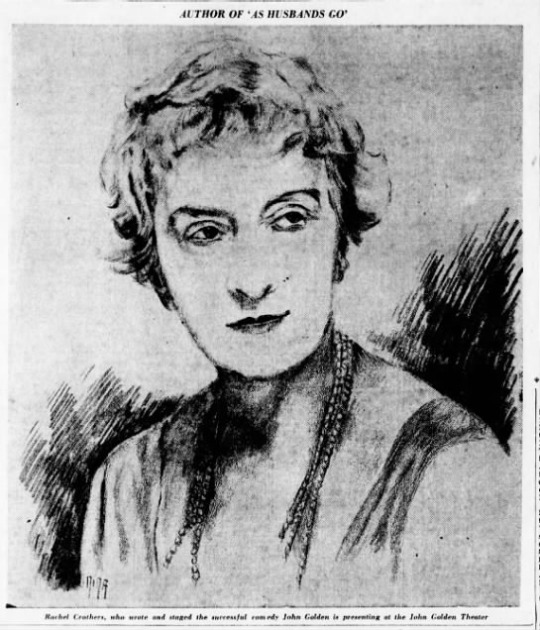
The play takes place at a café in Paris and the living-room in the Lingard House, ten miles from Dubuque, Iowa.
While in Paris, a widow from Iowa and her younger married neighbor, discover alluring gentlemen. The widow is attracted to an elderly boulevardier, while the neighbor is smitten with a handsome (and younger) English author. Instead of souvenirs, the ladies daringly bring the men back home to Iowa.
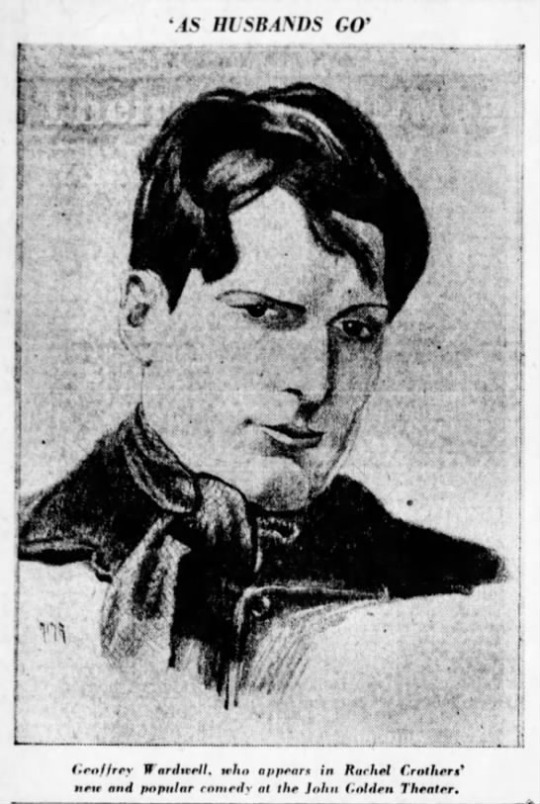
“If all husbands were as gallant as Charles Lingard in Rachel Crothers’ comedy... divorce courts could go out of business; that is, provided all wives were as delightfully tractable as pretty Lucile Lingard.” ~ BROOKLYN LIFE

For the world premiere, Golden chose Brandt’s Boulevard Theatre in Jackson Heights NY. It opened for a week’s stay on February 23, 1931.
The play premiered on Broadway at (fittingly) the John Golden Theatre on March 5, 1931. This was the first of three venues named for the producer. Located on 58th street, it stopped presenting live theatre in 1936 and was demolished in 1985. The third theatre named for Golden is now known as the Bernard Jacobs.

“If a smiling lady should be found dancing in the streets in Fifty-eighth Street, to be specific, with laurel and bay leaves in her hair, that would be Rachel Crothers. For the second time in three years she has taken advantage of John Golden's adventurous generosity and produced a hit in his name when he was no closer to it than Palm Beach, Florida. Ticket brokers, I'm told, are willing to buy all the seats the Golden office will sell for the next several weeks of ‘As Husband Go’, so sure are they that it is to be listed among the hits.”
Mantle is referring to the fact that Golden was seldom in Manhattan. In January 1931 he purchased the play from Havana, and was in Palm Beach when it finally opened.



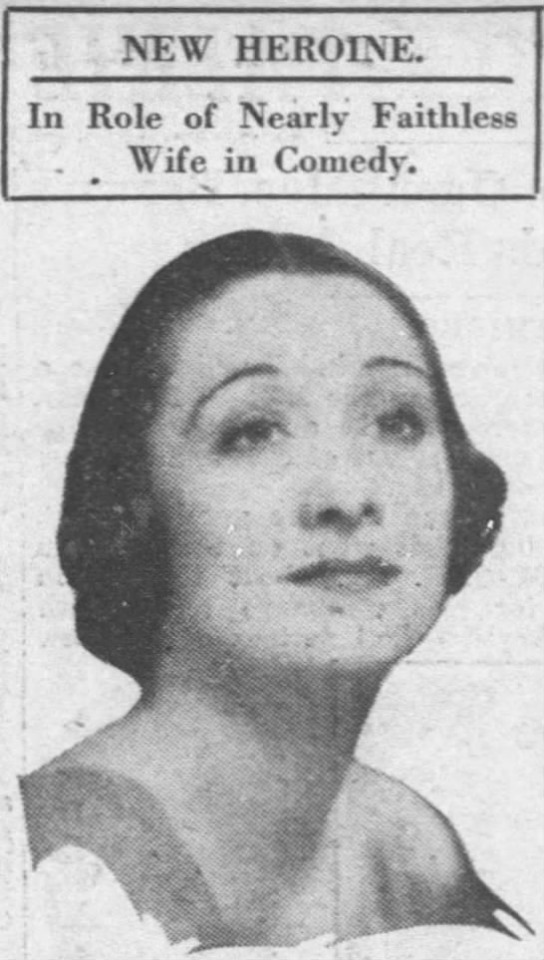
On May 4, 1931 Gloria Holden replaced Lily Cahill as Lucile Lingard. Cahill left the role suddenly for undisclosed reasons. Golden heard Holden on radio and signed her to make her Broadway debut.

The show’s 100th performance (a matinee on May 23rd) coincided with a military air show, so Golden moved the curtain time to 3:15pm to prevent audiences being distracted by the roar of aircraft motors.
At the same time in Los Angeles, producer E.E. Clive had presented a West Coast company of As Husbands Go. Clive would also produce the Broadway revival in 1933.

In late June 1931, Golden invested in some new-fangled technology - air cooling! Perhaps theatres would now be able to operate year-round? Cool!
After Independence Day, the play started to advertise “last weeks” and closed on July 11th. Golden had agreed to the play becoming one of the Theatre Guild’s subscription series. This was a consortium of cities nationwide that would share the same plays. One of those cities was Atlantic City.

Coincidentally, Clive’s California company wrapped up its run on September 12th, just as the Theatre Guild tour was preparing to launch. The production was integral in selling the play to Hollywood.

After a summer break, the play re-opened in Atlantic City at Nixon’s Apollo Theatre on the Boardwalk on September 28, 1931.
A new production, under the guidance of producers O.E. Wee and Jules J. Leventhal in mid-January. Again, Crothers provided direction. Wee and Leventhal were known as “W & L: The Revivers” with six productions in a short period of time - all revivals. Simultaneously, the play had been sold to stock and regional producers, virtually flooding the nation with Husbands!
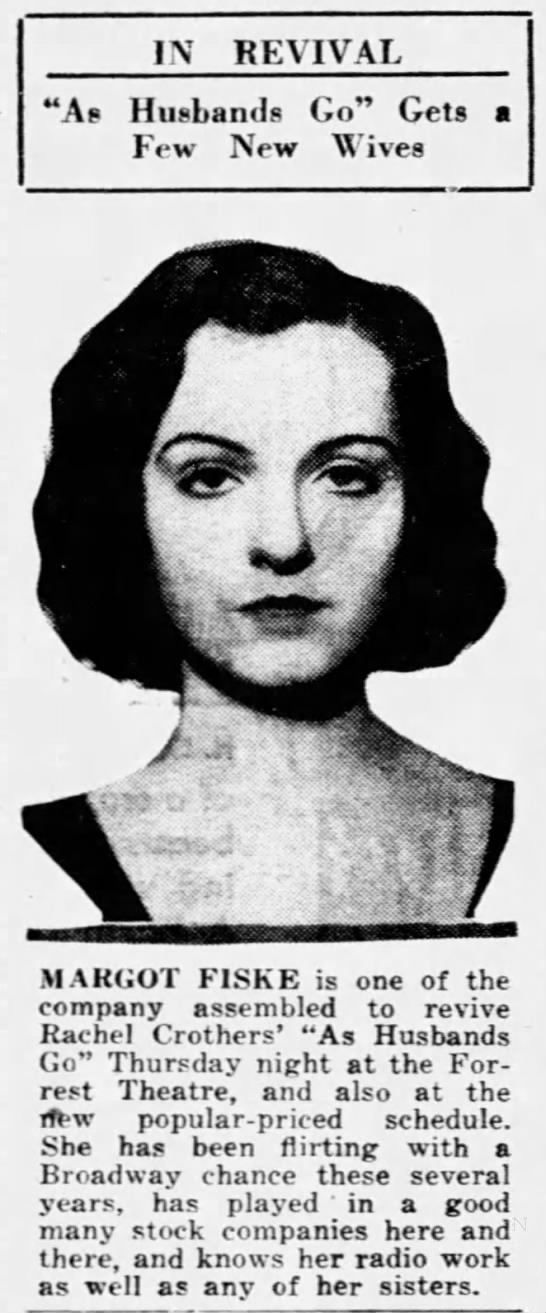
In January 1933, the play returned to Broadway at the Forrest Theatre, today known as the Eugene O’Neill. Remarkably, both the original Broadway production and the Broadway revival ran the same number of performances: 148.

In 1934, a film version was released. The screenplay was written by S.N. Behrman, Sonya Levien, and Fred Niblo Jr. and starred Warner Baxter as the titular Husband.

The film had its world premiere at the famous Steel Pier Theatre in Atlantic City on December 3, 1933, nearly two months before its general release in late January 1934.
#As Husbands Go#Rachel Crothers#1931#Broadway#Atlantic City#Broadway Play#Broadway Theatre#Nixon's Apollo Theatre#John Golden
4 notes
·
View notes
Note
Hello. Was reading Wikipedia page about Solomon Schechter (for reasons) which references a book you wrote about conservative Judaism. Clicking that link takes me to the jtsa Torah online page (glad to know about but not needed right now). A search of your name there was fruitless. Google was no help and Amazon, my baseline place to search for books, was no help either. Did you actually write a book on conservative Judaism? An article? Is Wikipedia confused again or am I? Many thanks.
I think you may have read too fast. I looked at the Wikipedia page and it references
Gillman, Neil (1993). Conservative Judaism: the New Century. West Orange: Behrman House. ISBN 0-87441-547-0.
And that is not me.
561 notes
·
View notes
Text
Okay...
Let’s talk “The Cinematic Voyage of The Pirate” by Earl J. Hess and Pratibha A. Dabholkar.
This husband and wife duo both specialize in different fields, but each loves the Hollywood musical. As such, they have written several books about musicals, specifically about Gene Kelly and his musicals. They wrote a making of Singing in the Rain Book & Gene Kelly: The Making of a Creative Legend in addition to their book on the Pirate.
Easily, their books on Gene Kelly are the best. They leave NO STONE unturned in their research. Myths that have been turned into fact are refuted, more on that later...basically, if you want to know all you can know about Gene Kelly, given his final wife, (~shudder~ I hate even TYPING THAT) PWK still hasn’t released the autobiography he wanted written for the world, Hess & Dabholkar’s books are the next best thing.
They’re pricey, NO LIE. The cinematic voyage of the Pirate will set you back around $25.00 on Amazon. Gene Kelly the creative legend? $35.00 on Amazon. The making of Singing in the Rain? $20.00 on Amazon for the paperback. And this is with ONLY black and white photos used, normally not on glossy paper, except in the making of SitR. As for finding a Hardcover of the making of SitR...good luck. I tried. Used copies in decent condition were in the $75+ range on eBay and used book sites. Acceptable condition was still hitting at $40-50 for a hardcover. First editions? I couldn’t even find one, but I’m confident if I did, the price would likely be in the $150-200 range. So I bought the paperback in the making of SitR.
The books are well made, yes even the making of SitR one I purchased. The details on Hess and Dabholkar books are why they are more pricey even on Amazon. They don’t use glossy paper for pictures or much, if any color photos, but the paper is lovely and thick, smooth and creamy. Nice type face, sewn binding, not just glued in & the cover is fabric, not a heavy colored paper cover. Gene Kelly: The Making of a Creative Legend” arrived in a box, wrapped in bubble wrap & the book still shrink wrapped in cellophane. Amazon rarely takes such time, but with the cost of the book, at least you know it will arrive in pristine condition.
These books are detail heavy & quite possibly hold every detail you wish to know. From his career to his childhood home, down to a map of the neighborhood he lived in and a picture of the house that still stands. Now...onto The Cinematic Voyage of the Pirate...
This book covers the movie and play in depth. They cover the original play by Ludwig Fulda, it’s translation and first life as a play under Behrman, Lunt and Fontaine. Nathaniel Behrman being the playwright who helped Lunt and Fontaine spice up The Pirate for the stage. Lunt recalled the translated Fulda version (it was originally in German) as “no great shakes as a play, but it did have a vastly amusing idea.” The play also gave Lunt the chance to eat a raw onion on stage, which he viewed as a highlight of his career.
All told, from Fulda to MGM’s film version, there were 8 different versions of stage plays and screenplays for the Pirate. Look below for a picture of the chart from the book about each.


There is a LOT of discussion in the book about each stage play and screenplay, especially in regards to their differences. Like...A LOT. If this type of stuff doesn’t interest you, maybe pass on this volume.
There was one item of interest though...namely the dance number that was supposedly so hot Mayer wanted it cut from the film and burned...yes, we are going to delve into VOODOO territory. According to Hess & Dabholkar, it wasn’t Voodoo that was too hot for Mayer, it was a take on the scene of Love of my Life...& they maintain that John Fricke’s comments on the DVD version of the Pirate, as well as Mark Griffith’s book on Minnelli as erroneously putting this forward. The page stating as such, is below. I marked the start of the passage. Crudely yes, but you get the idea😂

There is a lot in the book about the making of, but this was the newest information I saw. There’s tons of critical reviews and talk of how The Pirate found new life in later years becoming a cult classic and so on. There’s discussion about Gene Kelly becoming an object of desire for the gay community because of his Pirate ballet in tiny pants...which is understandable, he looks HOT.
All in all, the book has some black and white pics, all that I have seen online and a few interesting tidbits. The book is 258 pages and the final 71 are devoted to lines spoken in other stage play versions of the Pirate, discarded screenplays, crew and cast notes, an index, and more notes. It’s a nice book to have if you just HAVE TO HAVE all the books about Gene Kelly, as for new and interesting information? Not much. If you’re looking for stuff like that, I highly recommend Hess and Dabholkar’s “Gene Kelly: The making of a creative legend”, it’s great. Below I included a few pics of some of the images in the book. Sorry for the angle, my cat is asleep in my lap and I don’t want to wake him by moving. ❤️😂😂







#gene kelly#judy garland#song and dance man#mgm#the pirate#Hess & Dabholkar#the cinematic voyage of the Pirate#review
26 notes
·
View notes
Note
What is your thought about sending Jewish-themed picture books like on Tubeshvot or grief through the Jewish lens to literary agents? Are they really interested even though they say “please send Own Voices” which my picture books are or are those topics too specific and limited and will never sell?
Some agents are interested in Judaica, some aren't, just like anything else. I'd look in Publishers Marketplace at Jewish-themed books and publishers, and see who has sold them, as a start.
I will say that large publishers like to sell a LOT of books to a wide variety of people. So, the narrower or more "niche" your focus, the more likely that it would sell to a smaller Judaica-specific publisher, like Kar-Ben or Behrman House. Like for example, a book about, say, Food or Hanukkah or Immigration or something, that lots of people have heard of and might want a book about, might sell to any random publisher -- but a book about a specific part of the Talmud, say, or a less-widely-known holiday, is more likely to sell to one of the smaller Jewish presses. A book celebrating Trees is more likely to sell to a large publisher, whereas a book about celebrating Tu BiShvat specifically might be more niche. A book about the concept of social justice or "repairing the world" in a broad context including Judaism is more likely to sell to a large publisher, a book about the concept of "Tikkun Olam" quite specifically is likely to be more niche. You see what I mean?
So, I don't think it's a matter of "too specific and limited and will never sell" -- I just think you need to get a handle on what kinds of books you are trying to create. Are they books with Jewish themes that ALL kinds of people will seek out, or books that it is much more likely a primarily Jewish audience will seek out? Neither of those is a bad thing at all, it's just, the narrower your potential audience, the more likely that you'll be at a smaller publisher who focuses on books aimed at that specific audience.
And yeah - agents generally are likely to mainly focus on books they think will be broadly appealing, because, you know, we have to sell them, and so the more opportunities for that the better - so if ALL your books are EXTREMELY niche, we might not feel that we'd be of particular use in selling them.
The good news is, if you are doing somewhat more niche books and are not having luck getting agent's attention with them, many small presses do take un-agented submissions. So you could look at them, see what kinds of books they do and if yours will fit in, and try that route. For example:
https://store.behrmanhouse.com/index.php/blog/post/apples-and-honey-press-submission-guidelines-for-authors-and-illustrators
https://www.karben.com/submissions
2 notes
·
View notes
Link
Check out this listing I just added to my Poshmark closet: Hank on First! by Stephen Krensky (Trade Paperback).
0 notes
Note
hello sefa! i am trying to learn how to read hebrew fluently as part of my conversion, do you have any recs for apps/books/videos etc that explain how to read it including all the accents etc? i joined a class but because i joined a few weeks late, it seems that everyone already knows the basics and i'm trying to catch up before next week. thank you in advance!
unfortunately this is probably the aspect of hebrew i have the fewest resources for because i learned how to read it growing up and most of what i use with my sunday school students either costs money or was made by me :( i would assume the duolingo course is a good option, and i know there are free lessons on the behrman house website for sure, though.
let me know if you want me to share some of my sunday school stuff! (you'd have to come off anon tho bc i dont wanna just post a google drive link connected to my work account yk)
2 notes
·
View notes
Text
ENGINE KID SHARE PREVIOUSLY UNRELEASED TRACK "ANGEL DUST"
Appearing on Everything Left Inside, the 6xLP box set will be available for Record Store Day on June 12 (with additional format arriving later from Southern Lord and CD by Daymare Recordings).

Engine Kid, the 90’s post hardcore collective featuring Greg Anderson (Southern Lord label owner, also in Sunn O))), Goatsnake & Thorr's Hammer) share the previously unreleased track "Angel Dust" appearing on their special Record Store Day 6 x LP box set release Everything Left Inside.
About this track Greg Anderson comments, "during the process of unearthing ‘Angel Wings’ master tapes, a previously unreleased/unheard track from the session was discovered. Our recollections of this song were extremely foggy and the reason it was left off the full-length album remains a mystery! Vitality was injected into the track by wizard producer Brad Wood."
Listen to (+ share) “Angel Dust” on Bandcamp.
The Everything Left Inside box set includes other unreleased/unheard recordings as well as hard to find/sought after albums including the “Novocaine/Astronaut” 12”, Bear Catching Fish 2xLP, Angel Wings 2xLP and Split w/ Iceburn / Everything Left Inside 12” - all remastered and with an extensive 12-page booklet. A black vinyl version of the box is set for RSD on June 12th (not available outside the US) with additional versions of the record for the rest of the world to arrive at a later date. Digital for the time being is available via Bandcamp.
Watch the Everything Left Inside Unboxing video on YouTube.
Almost 30 years since the inception of Engine Kid, and the trio find themselves comprehending the enormity of their creation, honoring and celebrating the mountains they formed and the canyons they created.
Engine Kid was born in Seattle, WA in 1991. The band's original lineup consisted of guitarist/vocalist Greg Anderson (Southern Lord, Sunn O))), Thorr's Hammer, Goatsnake), drummer Chris Vandebrooke & bassist Art Behrman. The three had all been in hardcore/punk bands around town and all had a burning desire to create a sound that was unlike anything they had done in the past. After just a few months of existence they quickly recorded and self-released the Novocaine 7”. Circa 92’ a close friend and bassist Brian Kraft (Krafty) replaced Behrman, and at that moment the entire aesthetic and execution of sound became heavier, darker and extremely dynamic. The power trio was picked up by local label C/Z records and set out upon recording the new music they were quickly creating. In 1993 the band had two releases on C/Z. Their first offering was the Astronaut five song EP recorded by John Goodmanson. The songs were primitive and exemplified the bands worship of Slint and their loud/quiet song dynamic In the summer of 93’ the band drove all the way to Chicago to record with their hero Steve Albini in the basement of his house. They emerged with the eight song album they called: Bear Catching Fish. Albini intuitively captured the band exactly as they were at that moment: RAW, VULNERABLE, & MAMMOTH.
Shortly after the albums’ release Jade Devitt replaced Vandebrooke on drums. This transition was extremely crucial in the “second phase” of the group. Devitt was an absolute beast and his power helped launch the band miles beyond where they had ever been before. The sound of “The Kid” started to transform into a sound much more of their own. The three dudes were hellbent on pushing the bounds of sonic exploration to its absolute fullest. Suddenly there was an abundance of depth within the sounds they were creating. Eclectic influences of punk/hardcore (Black Flag, Die Kreuzen), Metal (Entombed, Carcass) and even jazz (Mahavishnu Orchestra, Miles Davis electric era) were in a full collision course with the already dynamically heavy foundation of the band. The levee had broken and the resulting flood of sound completely saturated everything in its path.
Engine Kid toured relentlessly. They were constantly on the road playing every nook and cranny they possibly could. Any moment not spent on the road was instead spent focused on making their new material as potent as possible. Early in 94' the band decided to pay homage to their mutual love of jazz/fusion and recorded three instrumental pieces that would become a split album with like minded powerhouse Iceburn. The Engine Kid/Iceburn album showcased each group's love of jazz loosely framed by the intense enthusiasm of underground music. The album was released by Revelation records in 1994.
During the summer of 94’ the band reconvened with producer John Goodmanson at Bad Animals & AVAST! studios to record the new material that was literally bleeding out of the reinvigorated trio. These recorded songs were much more progressive, heavier, harder and more focused than past works. They even tackled John Coltranes’ “OLE” adding saxophone and trumpet from their brothers in Silkworm. In March of 1995 Revelation records released these recordings as the Angel Wings album. Unfortunately "the Kid" flew too close to the sun and broke up very shortly after the album's release.
Everything Left Inside 6xLP box set (RSD release) includes:
LORD 288.1 Engine Kid-“Novocaine/Astronaut” 12”
LORD 289 Engine Kid-Bear Catching Fish 2xLP
LORD 290 Engine Kid-Angel Wings 2xLP
LORD 288.2 Engine Kid-Split w/ Iceburn /Everything Left Inside 12”
("Angel Dust" unreleased track cover art, download hi-res version here):

2 notes
·
View notes
Text
22/17
#23GloPoWriMo
Prompt Dated : 2023 April 17
Response No : 1
Poem No: 22
%^%^%^%^%^%^%^%^%^%^%^%^%^%^%^
Prompt :
Today’s challenge asks you to write a poem that contains the name of a specific variety of edible plant – preferably one that grows in your area.
In the poem, try to make a specific comparison between some aspect of the plant’s lifespan and your own – or the life of someone close to you. Also, include at least one repeating phrase.
%^%^%^%^%^%^%^%^%^%^%^%^%^%^%^
Poem Title :
The Milky Dudhiya Digha Maldah Mango
%^%^%^%^%^%^%^%^%^%^%^%^%^%^%^
Only about a hundred years
Is the life- span of the Dudhiya Maldah
The voluptuously fragrantly gorgeous Milky Mango
A cultivar of the magnificent Mangifera Indica
Grown only in the few square miles embraced
By the Ganga and the Sone in their eponymous confluence
In Digha, a name both generic for riverine confluences
And specific to the area of Patna where I live.
Digha, in Patna, is the name given
To a post office, a railway station, a boat harbour,
A cremation ghat, a police station, a community development block
A river bridge,a geographical location , and
To the most delicious Mango in the world
The Dudhiya Digha Maldah, in whose praise,
I am given to writing odes, Horation,
( after Andrew Marvell ), and paeans, pugnacious,
For I cannot possibly allow anyone anywhere
To contest the absolute supremacy
Of the Emperor among the Kings of Fruit, Mangoes,
In looks, in taste, in flavour, in fragrance,
In sweetness, in tartness, in juiciness,
In pulpiness, in satisfying scrumptiousness -
My pen and my life are ever at its command !
A Nawab of Awadh visiting Lahore in 1930
Picked up some saplings of a mango he liked
And brought them to his mother’s home in Patna
Planted them there and asked for surplus milk
From the royal dairy to be poured into the roots
Of these young saplings, not knowing their fruit
Forever would get sweetened by this care,
It’s very DNA would change and thus create
The Milky Digha Maldah Mango, much sought after
By kings and princes , premiers and presidents,
To this day, when kingdoms have vanished
And builders rule the roost, who have destroyed
It’s very habitat, rendering my pen,
And those of others here in this harsh world
It’s sole defence against the power of lucre.
2023, the Dudhiya Digha Maldah is dying ,
The Sacred Ganga helpless at Man’s greed
No water meadows lush with Ganga waters
No fat and happy cows fed on that grass
No milk to spare for watering Mango Trees
No land spared by the new-carved colonies
Markets and malls and big housing estates
Flyovers over black macadam roads
Concrete killing this precious habitat.
Only about a hundred years, then, has been
The life-span of this most wonderful of Mangoes
Created by Man working in harmony
With Mother Nature.
The Dudhiya Digha Maldah is dying
And helpless though fighting in its defence
So am I.
We cannot go out, you and I,
And reverse urbanisation and the end
Of pastoral life under ruthless neo- liberalism
We cannot fight the new Dragon, Development,
We will not hear the mermaids singing each to each.
One of these days
DDM and I
will quietly die.
It’s a bit like the Last Leaf
Only there’s no Behrman.
%^%^%^%^%^%^%^%^%^%^%^%^%^%^%^
Poet : Amita Sarjit Ahluwalia
Poem 22 / 17 th Day
%^%^%^%^%^%^%^%^%^%^%^%^%^%^%^
0 notes
Photo

Portsmouth Square c. 1856. In this elevated view north across the plaza, one can see the Bella Union Theatre, Verandah Saloon, El Dorado, Old City Hall, and Telegraph Hill in background. Photograph by T.E. Hecht for the George R. Fardon Photo Directory (from the GGNRA/Behrman GOGA 35346 collection).
Portsmouth Square 花園角: Chinatown’s Living Room
The late architectural historian, Phil Choy wrote in his classic book on the architecture of San Francisco’s Chinatown about the city’s Portsmouth Square park as follows:
“Once the Civic Center in San Francisco, Portsmouth Plaza today is the heart and soul of the Immigrant Chinese Community, used by the young and especially the elderly to escape the drudgery of their often cramped living quarters. When weather permits, women gather to socialize, chat, and play cards, and mothers watch their preschoolers at play, while men hover over players intent on outmaneuvering each other in the Chinese chess game, jook kay (“capture the flag”). few are aware that they are sitting at the birthplace of San Francisco, where their countrymen were among the multitude of gold seekers celebrating the admission of California to the union on [September 9], 1850. Nor do people realize these Chinese turned the fables of Gum Saan (Gold Mountain) into reality.“

The west side of Portsmouth Square, c. 1852. What would be come Chinatown had not yet been built.
“During the Spanish and Mexican periods of California history, Portsmouth Square was referred to simply as 'la plaza,' However, when Commodore John B. Montgomery of the USS Plymouth raised the American flag there to claim California during the war with Mexico, the plaza was officially named Portsmouth Square, and the street fronting the Bay was named Montgomery Street. Regardless of its designation, the early Chinese called it 'Fah Yuen Gok' (the 'park corner') [花園角], a name the community still uses today.

The south, or the future Clay Street, side of Portsmouth Square, c. 1852.
“The Square was the center for the City’s public celebrations and ceremonies. On August 28 1850, two prominent members of the Chinese community, Norman Asing and A-He, led the Chinese residents to the square in front of the old Mexican Customs House for a special public ceremony welcome them to the City. Mayor John Gary, Reverend Albert Williams, and other representatives of the city, presented the 'China Boys' (as they called themselves) with Chinese-language religious tracts that had been published in Canton. This event was the extension of the Protestant evangelical movement, the 'Second Great Awakening.'

The easterly view of Portsmouth Square, c. 1852, toward the future Kearny Street frontage.
"For over a century the square remained a rectangular sloping down from Walter U. Lum place (formerly known as 'Brenham Place') eastward to Kearny Street, bordered on the [south] by Clay Street and on the [north] by Washington Street. In 1960, to accommodate an underground parking garage for this car - congested area, landscape Architects Royston, Hanamoto & Mayes redesigned Portsmouth Square into the split-level park you see today.”
– from San Francisco Chinatown: A Guide to its History and Architecture, by Philip P. Choy

The West End Hotel. c. 1866 – photograph by Thomas Houseworth.

Chinese In Portsmouth Square. Photographer unknown (courtesy of Bancroft Library, UC Berkeley).

The Clay Street cable car line terminus at the southeast corner of Portsmouth Square, 1873. This photo is a detail from Carleton Watkins’ stereo card number 2368 (Variant) under the original title: “Clay St. Hill R.R., San Francisco, Cal. Run by A.S. Hallidie’s patent Endless Steel Wire Rope and Gripping Attachment. Overcomes an Elevation of 307 feet in a length of 2800 feet. Worst grade, one foot in six” (from the Marilyn Blaisdell Collection).
Historian Phil Choy wrote about the cable car terminus at Portsmouth Square as follows:
“Following Andrew S. Hallidie’s successful test-run of the first cable car on August 21, 1873, horse-drawn cars were replaced with a cable car on Clay Street. Thereafter, the Chinese called Clay Street ‘Mo Mah Lie Ch’eh,’ which literally means ‘no-horse-drawn-car’ [冇馬拉車; canto: “mou5 maa5 laai1 ce1″]. Starting from the top of Leavenworth Street, the line ended at a turntable at the bottom of Clay and Kearny Streets, to send the car back up the hill.”

“Kearny-street Plaza, San Francisco, Cal.” circa 1875 – photographer unknown. The elevated view northwest across the square shows the no. 11 Clay Street cable car at its Clay & Kearny Streets terminus. Waiting carriages and mature landscaping appear.

“152. Kearny street Plaza, San Francisco, Cal.” circa 1875. Photograph by Carleton Watkins (from the Marilyn Blaisdell Collection / Courtesy of Molly Blaisdell). This elevated, northwesterly view shows the northwest corner of the intersection of Kearny and Clay streets.

“Street View, Chinatown” c. 1891 -- Photographer unknown
This shot was taken of the northwest corner of the intersection of Kearny and Clay Streets.

Children of merchant Lew Kan and servant, c. 1900 -- photograph by Arnold Genthe

“A Picnic on Portsmouth Square” – photograph by Arnold Genthe
Jack Tchen: “This photograph shows the merchant Lew Kan’s four other children . . . . The woman on the left is his oldest daughter, who had a hunchback and never married. She and the family servant are shown here attending her three younger sisters. The two girls in the center are twins.”

“A Native Son, Portsmouth Square” – photograph by Arnold Genthe
Jack Tchen: “This boy is in everyday dress. Many babies wore bead bracelets around their right wrist. The cylindrical column behind his head is the Robert Louis Stevenson memorial statue of a clipper ship, which once stood on the northern side of Portsmouth Square.

The Robert Louis Stevenson memorial in Portsmouth Square park c. 1905. Photographer unknown (courtesy of California Historical Society). According to the San Francisco Art Commission, the memorial, designed by Bruce Porter and Willis Polk, was the gift of a committee of citizens aided by James D. Phelan in 1897 for Portsmouth Square Its plaque reads: "TO REMEMBER ROBERT LOUIS STEVENSON: To be honest, to be kind — to earn a little and to spend a little less, to make upon the whole a family happier for his presence, to renounce when that shall be necessary and not be embittered, to keep a few friends, but these without capitulation — above all, on the same grim condition, to keep friends with himself — here is a task for all that a man has of fortitude and delicacy..." (The inscription quotes from Chapter XII of Stevenson's A Christmas Sermon.)
The photographic record of Portsmouth Square show that Chinese and non-Chinese enjoyed the park. No less a personage than Robert Louis Stevenson made Portsmouth Square a favorite place for lounging. In its online website (https://robert-louis-stevenson.org/), the RLS Website Team writes about the monuments to Stevenson’s stays in San Francisco (December 1879 to July 1880, and June 1888) as follows
“San Francisco celebrates its association with Robert Louis Stevenson. His lodgings on Bush Street are marked with a bronze plaque. A memorial to RLS stands in Portsmouth Square, part of San Francisco’s Chinatown. RLS himself wrote about the city’s Chinatown, long before the memorial was erected: “Of all romantic places for a boy to loiter in, that Chinese quarter is the most romantic. [. . .] And the interest is heightened with a chill of horror. Below, you hear, the cellars are alive with mystery; opium dens [. . .] the seats of unknown vices and cruelties, the prisons of unacknowledged slaves and the secret lazarettos of disease” (“The Old and New Pacific Capitals”, The Works of Robert Louis Stevenson, Swanston edn, vol ii [London: Chatto and Windus, 1911], p. 163-64).”

A view west across Portsmouth Square to the line of buildings on Brenham Place, with the monument to Robert Louis Stevenson at center (photographer unknown, Martin Behrman Negative Collection / Courtesy of the Golden Gate NRA, Park Archives).
On the building seen at left, signage for what was probably the Wong Woo Sanitarium (at 776 Clay St.) is visible on the second floor balcony. The lanterns visible on the same balcony denoted the occupancy of a temple (the name of which is unknown). The second building façade from the left is probably no. 5 Brenham Place, the building of the California Chinese Mission and school. By 1900, the bell tower had been removed from the firehouse, the driveway of which is seen at the center of the photo. The city’s 1885 map showed the rest of the buildings from the center to the right of the photo were used for “lodgings.” Not seen at the northwest corner of Brenham Place and Washington Street is the space occupied by the “Chinese Tea and Herb Sanitarium”’ at 727 Washington Street which also served non-Chinese clientele (and formerly the establishment of the well-known doctor, Li Po Tai, who had passed away in 1893).

c. 1900 -- photographer unknown. Probably old City Hall in the background on Kearny Street.

“The Airing,” Portsmouth Square off Washington Street. Photograph by Arnold Genthe.
Jack Tchen: “The four children are being taken care of by an “uncle.” It is highly unlikely that this weatherworn, poorly dressed man was wealthy enough to have his own family. The shadows of Genthe and his assistant are in the foreground. As evidenced by the crop marks, Genthe printed the four people on the right as a separate photograph.

A crowd gathers in Portsmouth Square to watch the fire that followed the 1906 earthquake (photographer unknown, courtesy of California Historical Society)

Chinese and other refugees gather in Portsmouth Square after the earthquake. (Photograph unknown, courtesy of California Historical Society)

Temporary gravesites in Portsmouth Square following the earthquake and fire. (Photo courtesy of California Historical Society)
“Bodies were scattered all over the city. They were being buried by gangs of men impressed by the soldiers. In three days thirty-two Chinese and whites were buried in Portsmouth Square alone. Few of the bodies were identified, most of them being burned beyond recognition.” -- from “San Francisco’s horror of earthquake and fire: terrible devastation and heart-rendering scenes”

Four boys in knickers and newsboy-type caps sitting on a bench outside an earthquake shack, assumed to be in Portsmouth Square, c. 1906. In the aftermath of the Great Earthquake and Fire of April 1906, a refugee camp at Portsmouth Square eventually held 37 cottages for Chinese families out of 153 total cottages there. Photographer Unknown (Marilyn Blaisdell Collection / Courtesy of Molly Blaisdell).
[updated: 2024-9-21]
1 note
·
View note